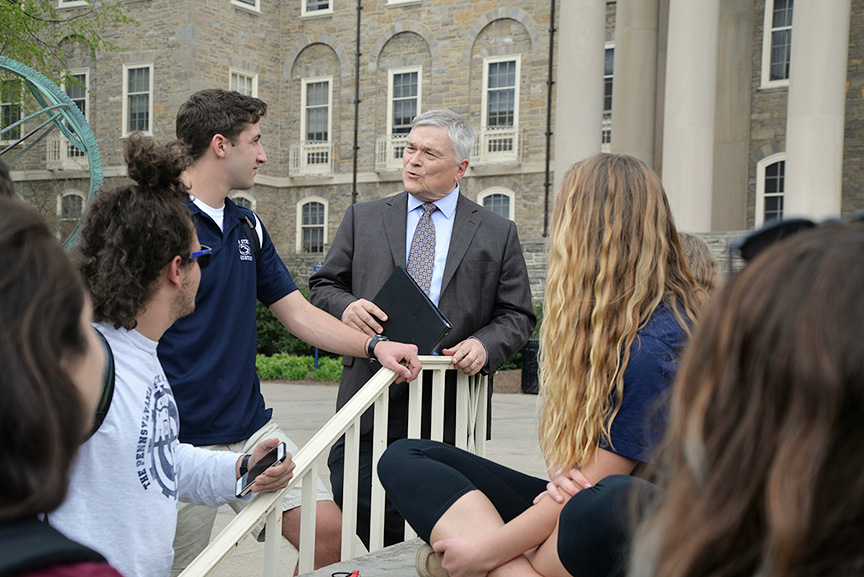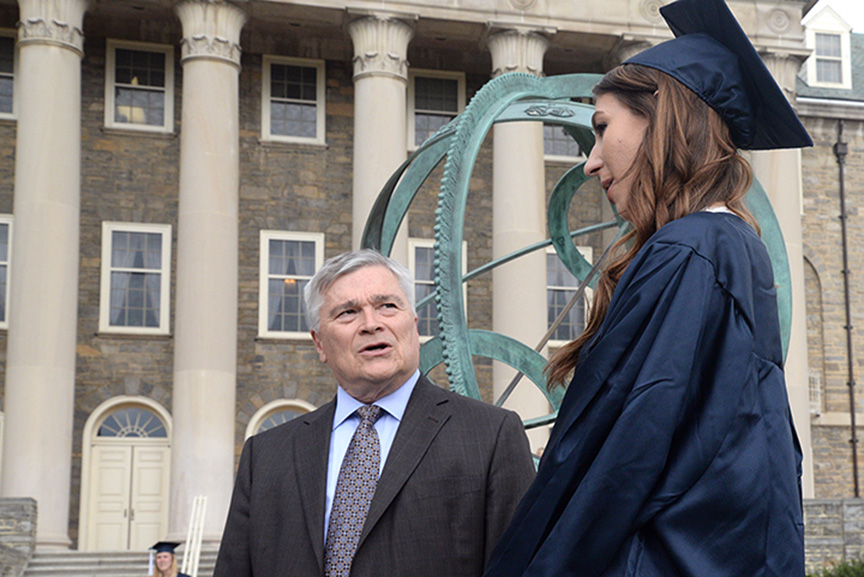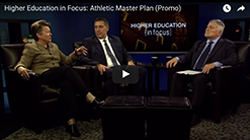An Open Letter to Penn State’s Greek Community
Many members of the Penn State administration and Board of Trustees are wondering if we are witnessing the beginning of the end of Greek life at Penn State.
Seventeen percent of Penn State students are in a fraternity or sorority. We know that students in Greek life self-report excessive drinking that is four times higher than the average student. We know that the vast majority of sexual assaults are associated with alcohol and that an association with Greek life yields a sexual assault victimization rate that is 50 percent higher than the average student. We also know this is a national problem plaguing this generation of students at universities across the country.
For a decade, we have tried to address these problems in myriad ways, recognizing that Greek houses are privately owned, managed by external parties, sanctioned by national organizations, and are not under the jurisdiction of University Police.
We require all first-year students to complete online alcohol and sexual assault education programs. We added a session for parents and students in New Student Orientation on health and safety, covering alcohol poisoning, the connection between alcohol and sexual assault, and information about both Pennsylvania laws and University policies. Every first-year student receives three communication pieces from University Health Services at all alcohol education workshops. We require that fraternities and sororities participate in educational programs on alcohol, sexual assault, and hazing. We require students who have violated laws or policies related to underage drinking, public drunkenness, excessive consumption, or driving under the influence, either on or off campus, to attend two private sessions with trained alcohol counselors in our BASICS program and hold them accountable through the University’s conduct process. Yet excessive drinking and sexual assault continue.
We have worked hard to partner with the Interfraternity Council and the Panhellenic Council to try and convince Greek-life-leaders to self-police and self-regulate adverse behavior. After all, our students are adults and must accept responsibility for their actions.
But the case of Kappa Delta Rho (KDR) was particularly troubling because the evidence from State College police suggested several instances of hazing, the use and sale of drugs and underage drinking, and harassment of females. KDR lost its recognition by the University for three years, forcing the members to vacate their house. The decision to revoke recognition of a fraternity or sorority is typically a joint action between Greek-life-leaders and the University in cases where the behavior is particularly problematic. Nationally, the revocation of recognition and vacating of a house, is the most severe of penalties that can be levied against fraternities.
In the case of KDR, Penn State’s Interfraternity Council decided to continue to recognize the group, with certain stipulations. But Penn State imposed a more severe three-year suspension. The behavior at KDR was so disturbing that I also created a Task Force on Fraternity and Sorority Life. The goal was to maximize the benefits of Greek life and minimize the negative behaviors. The Task Force was set up to reach consensus by combining the views of the State College community, Greek life and the University. The Task Force reached agreement on some areas, including a new “report card” that would inform parents and students about everything from average grade point to service hours to police citations and sanctions. The objective was to provide a “buyer’s guide” to help students avoid groups that had poor records and be attracted to groups with good records. The thinking was, that perhaps a “buyer’s guide” would affect the economic status of the house. At the same time it could reveal any negative trend in behavior over time, allowing us to intervene earlier by putting a house on notice. The Task Force did not reach consensus on the more challenging issues surrounding the control of excessive drinking and large parties at fraternity houses.
But surely the closure of a chapter and vacating of a house would be a deterrent for all others, and a “report card” would provide warning signs on when an intervention was needed. The tragic and heart-wrenching death of a student at the Beta Theta Pi fraternity completely changed this view. The Beta fraternity was viewed as a model fraternity and reflected a national perspective on many best practices. The house, privately-owned and situated like all other fraternity houses on private property, was beautiful, the subject of a multi-million dollar renovation. Both the Beta alumni and the national organization provided strict rules of behavior. The brothers had a ‘no alcohol’ policy, which stated that anyone caught drinking would be expelled from the fraternity. There was live-in oversight as contracted through an external agreement with the national organization. The owner of the house wired it for video surveillance. There were no outward signs of large parties, which are frequently the bane of community members. All indicators suggested a “model” fraternity. Yet, a death occurred because a student was forced to consume dangerous amounts of alcohol in a hazing ritual. The story is even worse. The story is incomprehensible.
Beta has been permanently banned at Penn State. Its “model” behavior was a charade. Despite all of the efforts above, the evidence of problems within the University’s Greek-letter community remain. The University made the decision to impose new, more aggressive measures, including:
- Formal recruitment of new fraternity and sorority members, also known as rush, will be deferred one semester so that only students who have completed 14 credit hours may participate. No new freshmen at Penn State will be able to rush next fall. In consultation with various constituents within the Penn State Greek-letter community and their national organizations, other requirements and the possibility of deferring rush until a student’s sophomore year will be considered for 2018-19. Further discussion about the size of new membership classes within these organizations will be part of an ongoing review.
- New social restrictions will include a strongly enforced prohibition against underage possession or consumption of alcohol in chapter houses and activities. Service of alcohol at social events must follow Pennsylvania law (e.g. limited to those 21 years of age or older), and must be distributed by RAMP trained servers only, though third party, licensed RAMP certified servers are preferred. Only beer and wine may be served, and kegs will not be permitted.
- Attendance at social events will be limited to the legal capacity of the chapter house. No day-long events will be allowed, and no more than 10 socials with alcohol per semester will be permitted for each chapter, a reduction from the current limit of 45, which was established by Penn State’s Interfraternity Council.
- Failure by the Greek-letter organizations to effectively prevent underage consumption and excessive drinking in their facilities and activities may lead the University to adopt further restrictions, including the possibility of declaring that the system must be completely dry.
- These social restrictions will be enforced by a new monitoring protocol that will use both third parties and a combination of student leadership and University staff. When discovered, any violations of these expectations will result in appropriate and significant disciplinary action.
- There will be no tolerance for hazing in these organizations, as all hazing is a violation of Pennsylvania law. Hazing that involves alcohol or serious physical abuse will likely lead to loss of University recognition. Increased educational programming focused on preventing hazing will be mandatory for all chapter members.
These steps build upon the University’s general moratorium on socials involving alcohol through the remainder of the spring semester.
We allowed one social event involving alcohol as long as all of the rules above were followed – Parent’s Weekend. Apparently this was a mistake. Nine of the University’s 82 fraternities and sororities that we know about violated at least one rule, and one fraternity – Sigma Alpha Mu – violated almost every rule that was imposed. The drinking was excessive and was not restricted to beer and wine. There was no third-party licensed server. The party was open to anyone and people with no formal association roamed freely in and out with access to handles of liquor. Those roaming in and out included some who were underage. Even some parents were visibly intoxicated. Now, these fraternities, particularly Sigma Alpha Mu, face decisions by the University.
Equally troubling are the signs that bad behavior will not end with our rules, it will just go underground. After the new rules were announced, an email from an IFC leader was sent to chapters using a derogatory term to describe women, while encouraging members to have the alcohol upstairs and not have it on the main floor where it risks having checkers discover a violation.
If new rules can just be ignored, or behavior just goes underground, and if there is no willingness to recognize the adverse impact of excessive drinking, hazing, and sexual assault, then is there any hope?
In the past, Greek life had a powerful positive effect on many of our alumni. The positive is well worth protecting – the value of brotherhood and sisterhood and the great service associated with Greek life. But the stories cited above cannot continue. If they do, I predict that we will see many empty houses and then the end of Greek life at Penn State.







